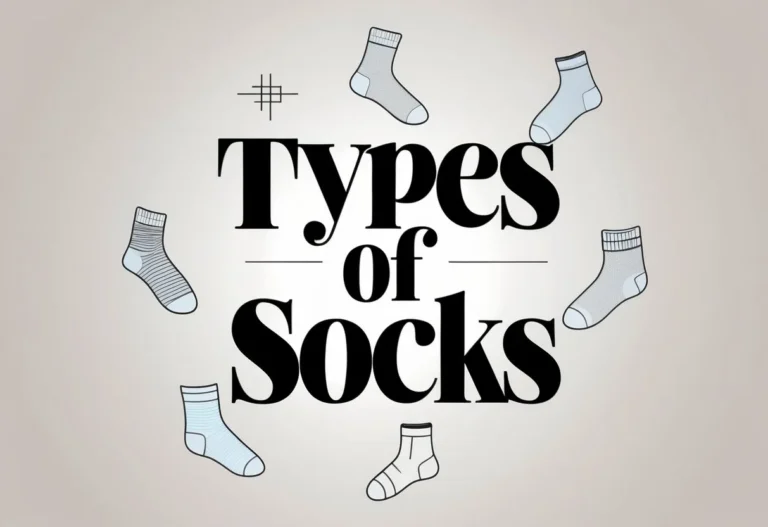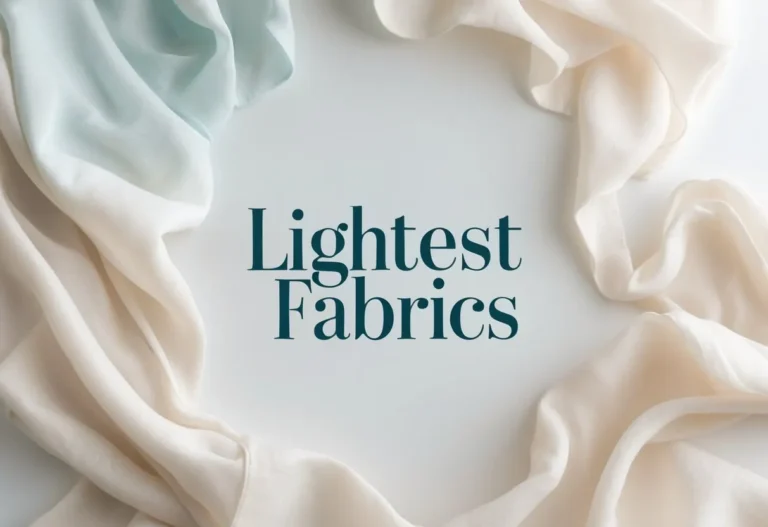14 Different Types of Jeans Stylish Denim Choices
Jeans are a popular clothing item worn by many people around the world. They come in different styles, fits, and colors, but what often gets overlooked is the variety of materials and fabrics used to make them. Understanding these materials can help people choose the right pair for comfort, durability, and style.
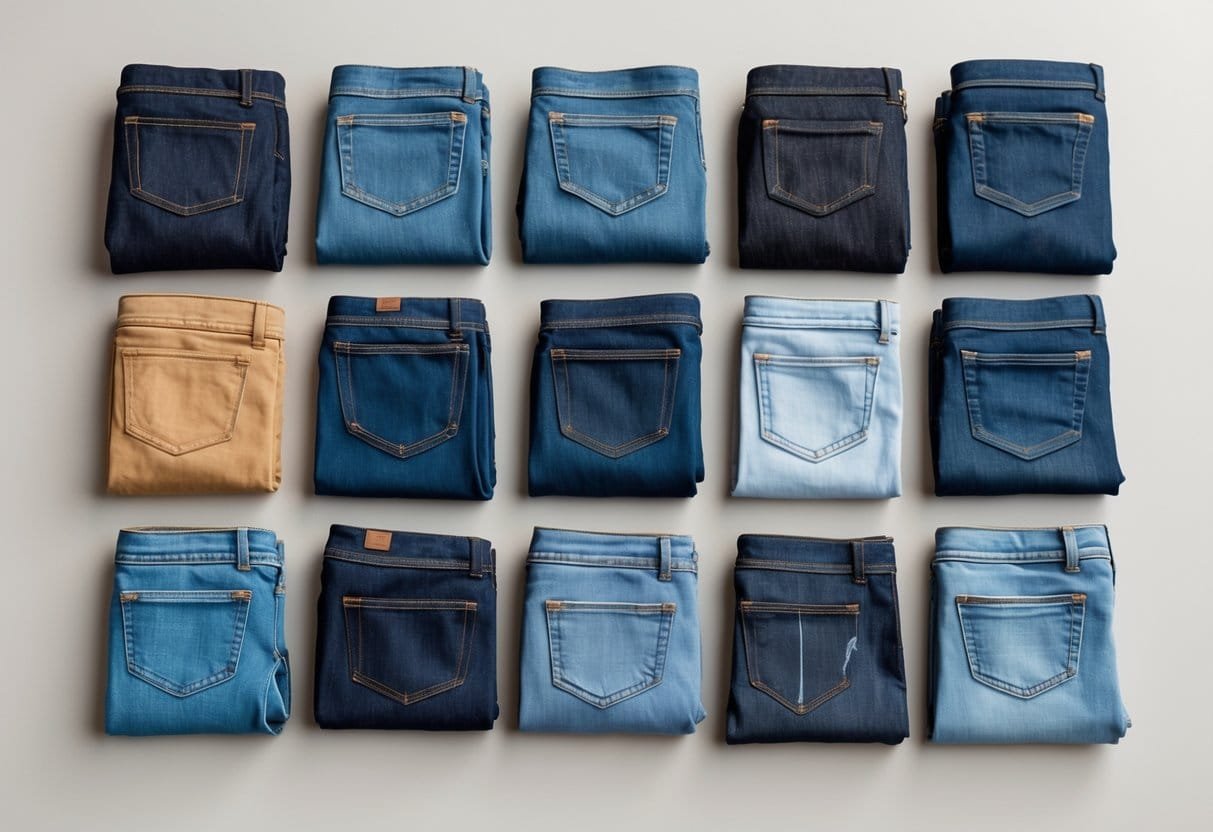
The key to knowing what makes jeans unique lies in the Types of Jeans Materials and materials used during their production. Each fabric brings different qualities, like stretch, weight, and texture, which affect how the jeans look and feel. This article explores 14 different types of jeans materials and fabrics to provide a clear view of what sets them apart.
1) Raw Denim

Raw denim is denim fabric that has not been washed or treated after the dyeing process. It retains a deep indigo color and a stiff texture because it has not gone through any softening or fading.
This type of denim is known for being very durable and strong. People who wear raw denim often appreciate the way it fades uniquely over time, creating personalized patterns based on their daily movements.
Raw denim requires more care compared to washed denim. It may feel uncomfortable at first because it is stiff, but it becomes softer with wear. Many denim enthusiasts prefer raw denim because it offers an authentic and rugged look.
It is popular in both traditional jeans and fashion pieces. Since raw denim is not pre-washed, it might shrink slightly after the first wash. This fabric is often used in higher-quality jeans because of its durability and unique aging process.
2) Selvedge Denim
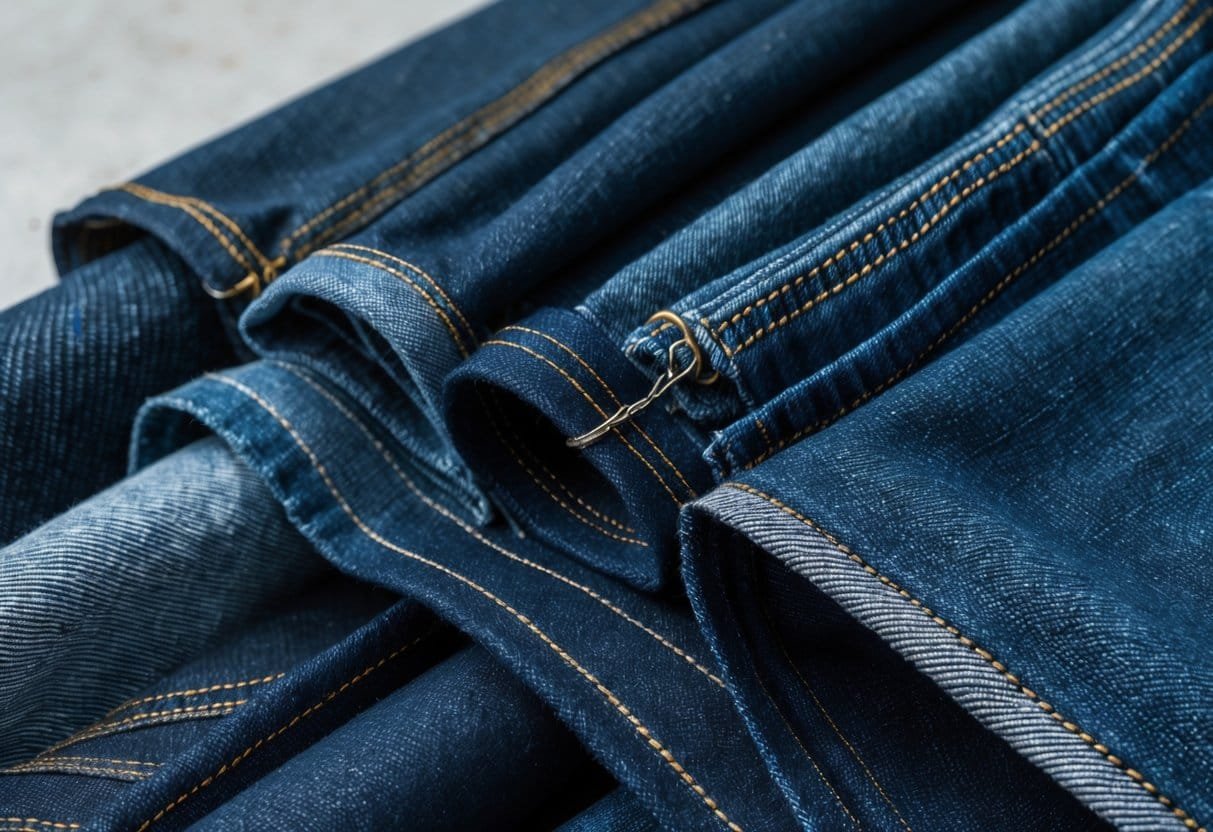
Selvedge denim is a type of premium fabric made on traditional shuttle looms. This old-fashioned method weaves the fabric tightly, creating a clean, finished edge that stops fraying. The edge, or selvedge, often has a colored thread, usually red, white, or blue, visible on the inner seams.
Because of the way it is woven, selvedge denim tends to be denser and stiffer than regular denim. This makes it more durable and gives it a distinct feel. It also ages well, developing unique fades over time that show wear patterns clearly.
Selvedge denim is linked to traditional textile techniques and appeals to those who appreciate craftsmanship. It usually comes in different textures and weights, sometimes mixed with other fibers like elastane for stretch or polyester for strength.
People who buy selvedge denim look for quality and longevity. While often more expensive, it is valued for its durability and classic style.
3) Stretch Denim

Stretch denim is made by blending traditional cotton denim with a small amount of elastic fibers, like spandex or elastane. This mix allows the fabric to stretch and move with the wearer, offering more flexibility than regular denim.
It is a popular choice for jeans because it improves comfort and fit. Stretch denim adapts to body shape, making jeans less stiff and easier to wear for long periods. Unlike baggy or saggy jeans from older denim styles, stretch denim keeps its shape better over time.
This type of denim works well for skinny jeans, jeggings, and activewear. However, the amount of stretch can vary depending on the fiber blend. Some stretch denim has just a little elasticity for mild flexibility, while others have more for a tighter, more flexible fit.
Care is important with stretch denim. Washing it gently and avoiding high heat helps keep the fibers from breaking down. Stretch denim offers a blend of comfort and style that suits many different needs.
4) Colored Denim
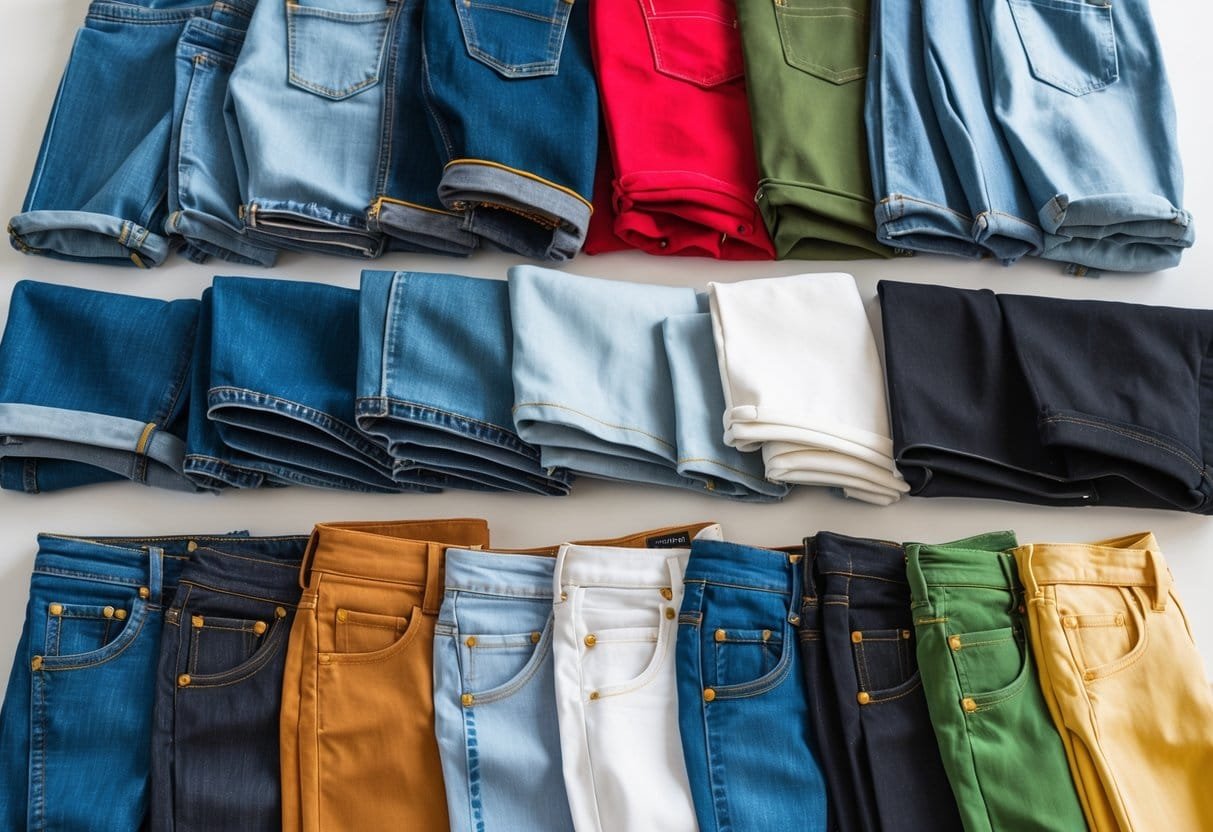
Colored denim is made by dyeing the fabric after it has been woven. Unlike traditional indigo denim, which shows the blue and white twill pattern, colored denim can come in many shades like red, green, or yellow. This gives jeans and jackets a different look without changing the strong, twill weave of denim.
The process used for colored denim is often called piece dyeing. This method changes the fabric’s hue but keeps its texture and durability. Because colored denim is dyed as a whole piece, it may fade or wear differently than regular blue denim.
Colored denim offers more style options for those who want something different from classic blue jeans. However, it may not have the same vintage feel or fading behavior as traditional denim. It remains a popular choice for fashion due to its versatile appearance and solid denim qualities.
5) Stonewashed Denim
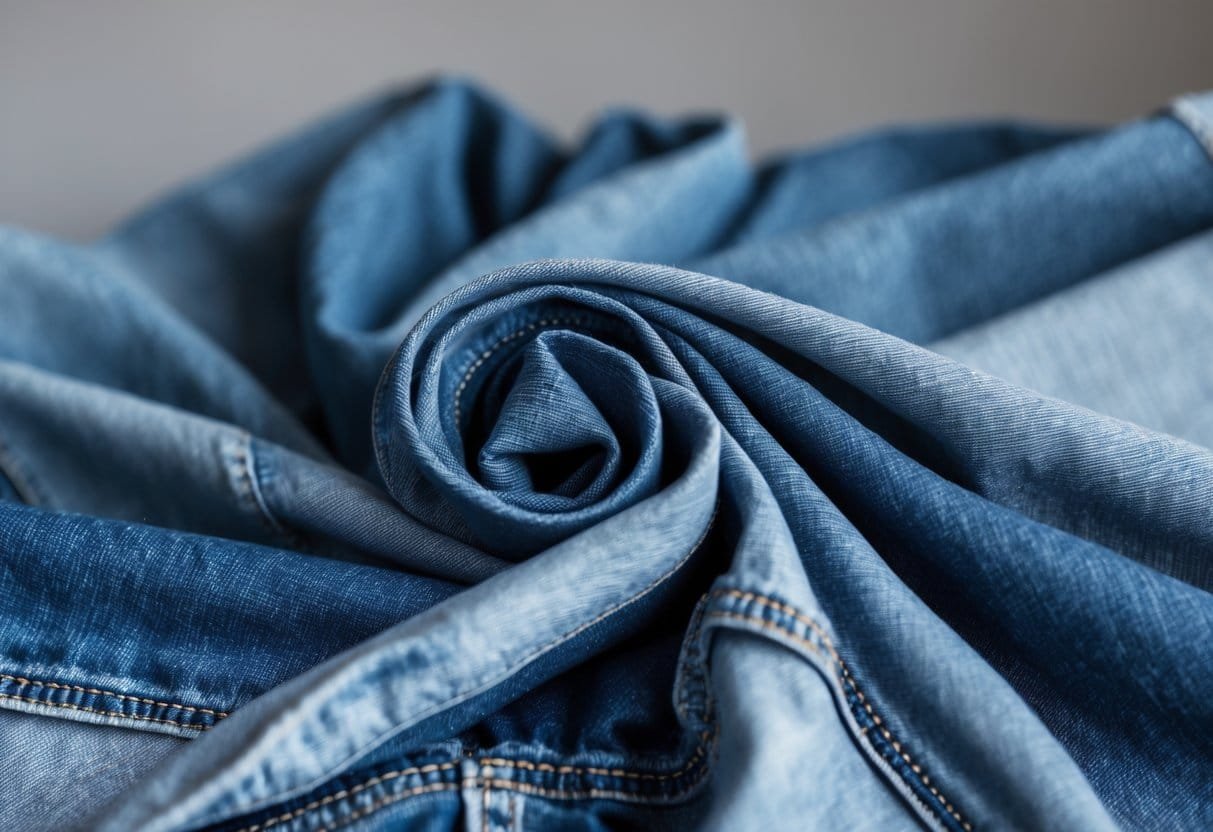
Stonewashed denim is made by washing the fabric with pumice stones or other abrasive materials. This process helps break down the fibers and dye in the denim. As a result, the jeans get a faded and worn-in look.
The stones rub against the fabric during washing, softening it and giving it a vintage feel. This makes stonewashed denim more comfortable to wear right from the start. It also gives the jeans a unique texture that is different from regular denim.
This technique became popular in the 1970s and changed how denim was made. While the jeans still use the same cotton fabric, the stonewashing process creates a distinct look. Many people prefer stonewashed denim because it looks less stiff and more lived-in compared to raw denim.
Stonewashed jeans can vary in how much fading or distress they show, depending on the washing time and the stones used. This style works well with casual outfits, pairing easily with t-shirts and jackets.
6) Acid Washed Denim

Acid washed denim is a style of jeans that shows a mottled, faded look. This effect comes from treating the fabric with chemicals or scrubbing it with a pumice stone dipped in chlorine. The process removes some of the dye, creating a unique, worn appearance.
This type of denim became popular in the 1980s and has since seen several comebacks in fashion. Its distinctive look makes it different from regular blue denim or other washed styles. Acid washed denim tends to have a lighter color with patches of darker and lighter areas.
Because of the chemical treatment, acid washed denim can feel softer than raw or dry denim. However, the finish may make the fabric weaker if not treated carefully. People often choose acid wash jeans for their vintage vibe and bold style.
7) Rigid Denim
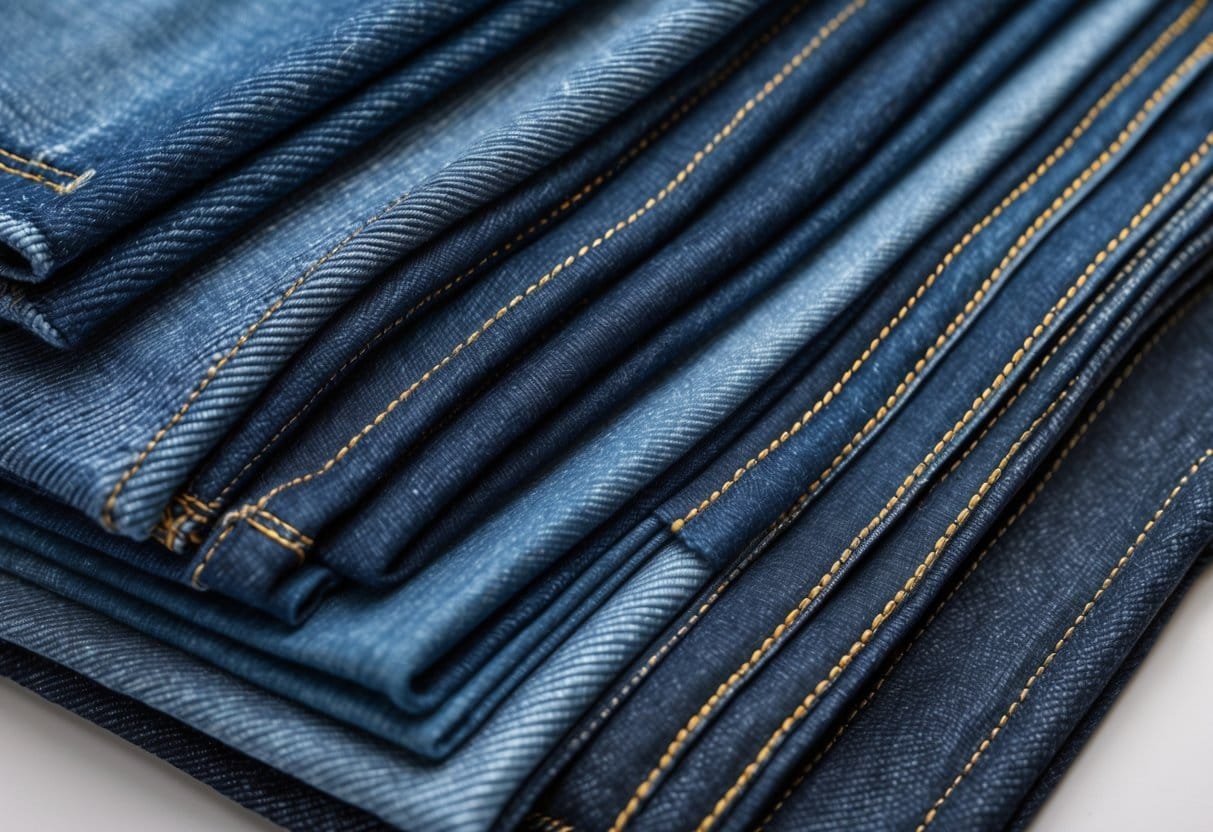
Rigid denim is made from 100% cotton and is known for its stiff and sturdy feel right out of the box. It is also called raw or unwashed denim because it does not go through any washing or softening during production. This makes the fabric tougher and less flexible compared to other types of jeans.
Wearing rigid denim takes time to break in. As it is worn, the fabric slowly softens and molds to the shape of the wearer’s body. This process creates a personalized fit and unique fading patterns that many denim fans appreciate.
Because it is made from mid to heavyweight cotton, rigid denim holds its shape well. This durability is one reason why it remains popular among those who want long-lasting jeans. However, some may find them uncomfortable at first due to the stiffness.
Rigid denim requires special care, such as infrequent washing and gentle handling. This helps preserve the fabric’s strength and allows it to age naturally. People often choose rigid denim for its classic look and lasting quality.
8) Twill Denim

Twill denim is a type of fabric made with a distinct diagonal weave pattern. This weave gives the fabric its strength and durability, making it a common choice for jeans. Most denim is created using this twill weave, which sets it apart from other cotton fabrics.
The diagonal lines on twill denim are easy to spot and provide a unique texture. This design helps the fabric resist wear and tear, which is why twill denim is popular for workwear and casual clothing. It also allows the jeans to stretch slightly while maintaining their shape.
Twill denim often uses cotton as the main fiber. However, sometimes blends with other materials are used to add stretch or change the feel of the fabric. It is versatile and can come in various weights, affecting the comfort and durability of the jeans. Its classic look and toughness make twill denim a staple in jean fabrication.
9) Organic Cotton Denim
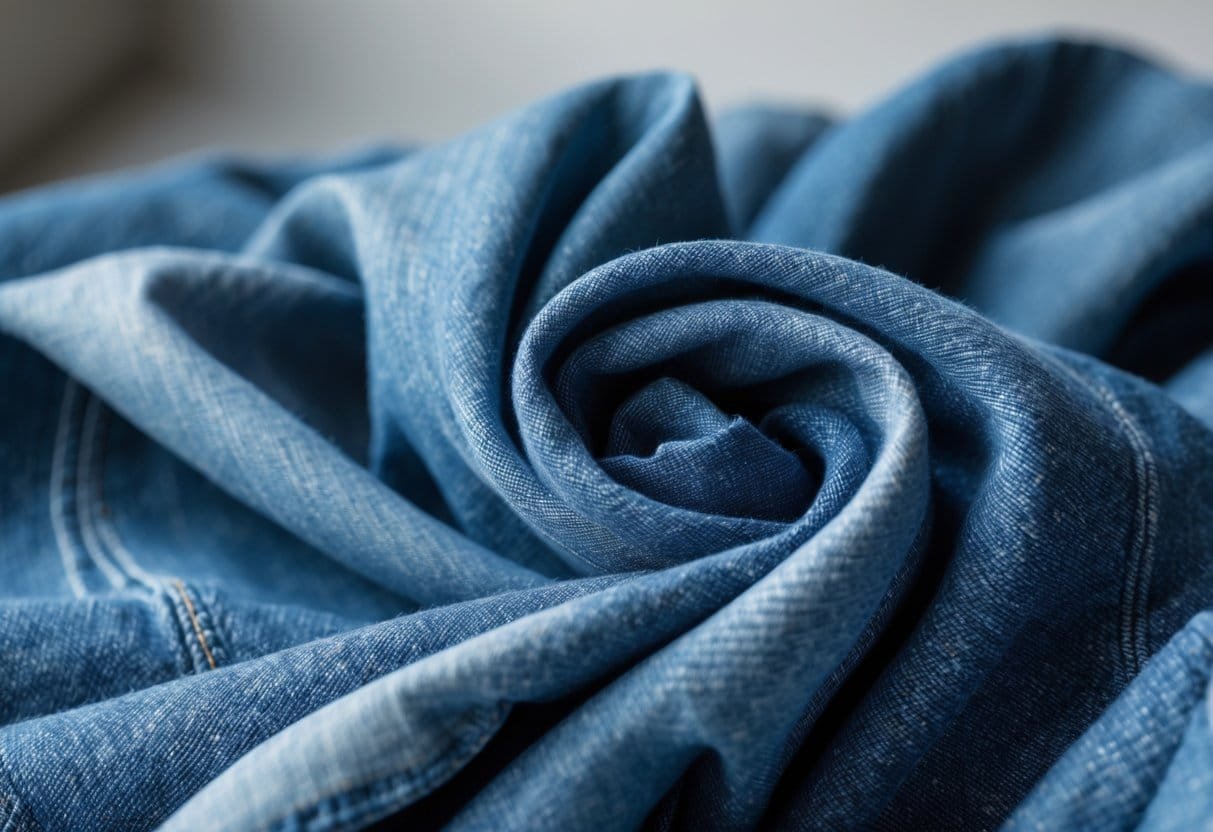
Organic cotton denim is made from cotton grown without synthetic pesticides or fertilizers. This farming method helps reduce environmental impact by preserving soil health and reducing water pollution.
The fabric looks and feels like regular denim but is better for the planet. Many brands now use organic cotton denim to offer eco-friendly jeans that maintain durability and comfort.
Some organic cotton denim blends include hemp or recycled cotton, which add strength and sustainability. These blends still provide the classic denim look while supporting cleaner production methods.
Caring for organic cotton denim is similar to regular denim. Washing in cold water and air drying can help preserve the fabric and reduce energy use, making the jeans last longer.
Overall, organic cotton denim allows consumers to choose jeans made with fewer chemicals and more environmentally friendly processes. It fits well with the growing demand for sustainability in fashion.
10) Polyester Blend Denim
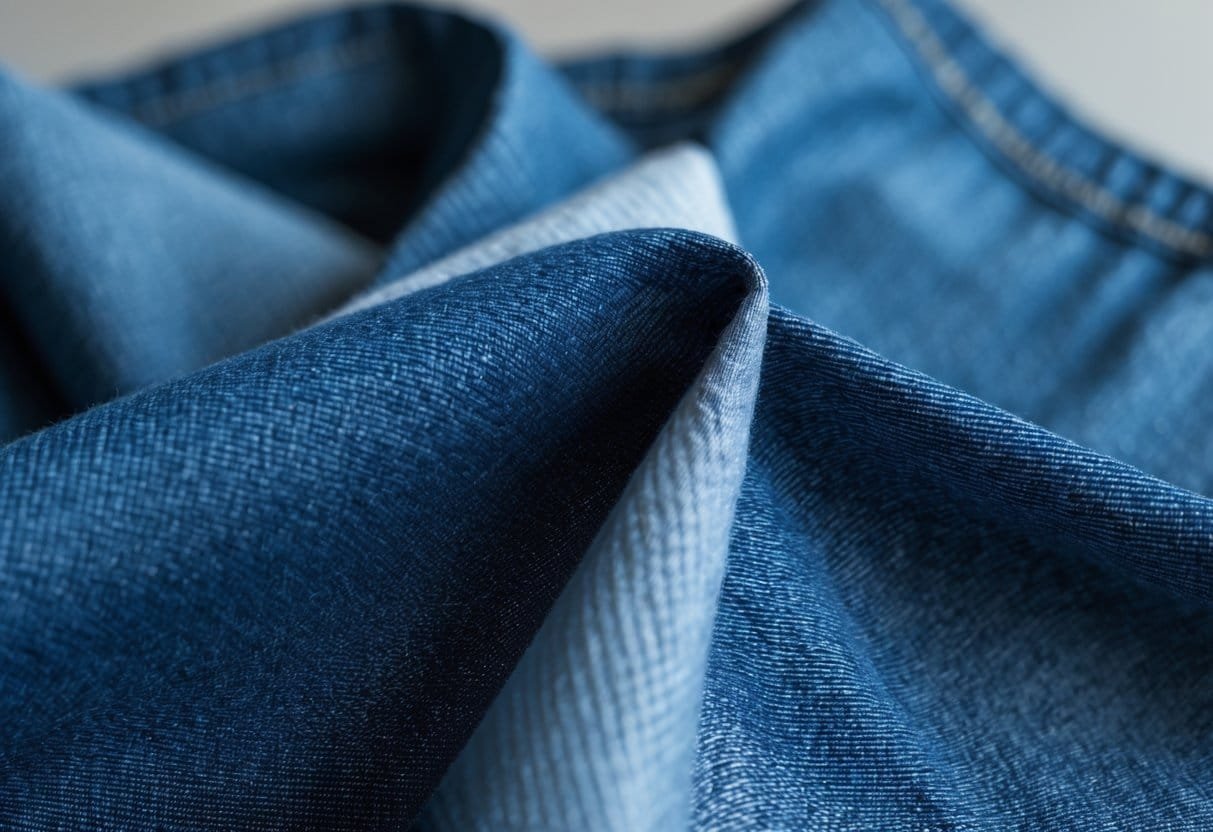
Polyester blend denim mixes polyester fibers with cotton. This combination changes the feel and performance of regular denim. The amount of polyester can vary, but it usually adds strength and wrinkle resistance.
This type of denim is often more durable than pure cotton denim. It can handle wear and tear better. The blend also helps jeans keep their shape after multiple washes.
Polyester blend denim may feel less soft compared to 100% cotton denim. However, it often feels lighter and more flexible. This makes it popular for active wear or work jeans.
Because of polyester’s properties, these jeans dry faster. They also resist shrinking and stretching out. This makes the fabric easier to maintain over time.
Overall, polyester blend denim offers a balance between comfort and durability. It is a practical choice for people who want jeans that last longer without much care.
11) Corduroy Denim

Corduroy denim is a blend of two fabrics: corduroy and denim. It combines the soft, ribbed texture of corduroy with the durable weave of denim. This fabric offers a unique look that stands out from regular denim.
Unlike traditional denim, corduroy denim has raised ridges called wales. These wales give it a textured feel and a warmer, softer touch. It is often used to make pants and jackets that are comfortable yet sturdy.
Corduroy denim is heavier and warmer than regular jeans, making it suitable for cooler weather. However, it may not be as breathable as pure denim. Stretch versions add flexibility, improving comfort during active wear.
This fabric is popular for casual, vintage-inspired styles. It provides a fresh alternative for those who want the durability of denim with a distinct fabric texture. Corduroy denim blends style and function in a practical way.
12) Chambray Denim

Chambray denim is a lightweight fabric that looks similar to traditional denim but feels much softer. It is woven with a simple weave, usually using a colored thread on the warp and a white thread on the weft. This gives it a smooth surface and a more breathable quality than regular denim.
Unlike heavy denim, chambray denim is thinner and works better for warm weather or casual, comfortable clothing. It offers a lighter and cooler alternative while still maintaining a denim-like appearance. Designers often use chambray denim for shirts, summer jackets, and light pants.
The fabric’s weight usually falls between 2 to 4 ounces per square yard, much less than the heavier denim that can weigh up to 32 ounces. Due to this difference, chambray denim is less rugged but more flexible and softer on the skin.
Chambray denim offers versatility in style. It has a cleaner and softer look compared to the rough and sturdy feel of classic denim. This makes it suitable for casual wear where breathability and comfort matter.
13) Slub Denim
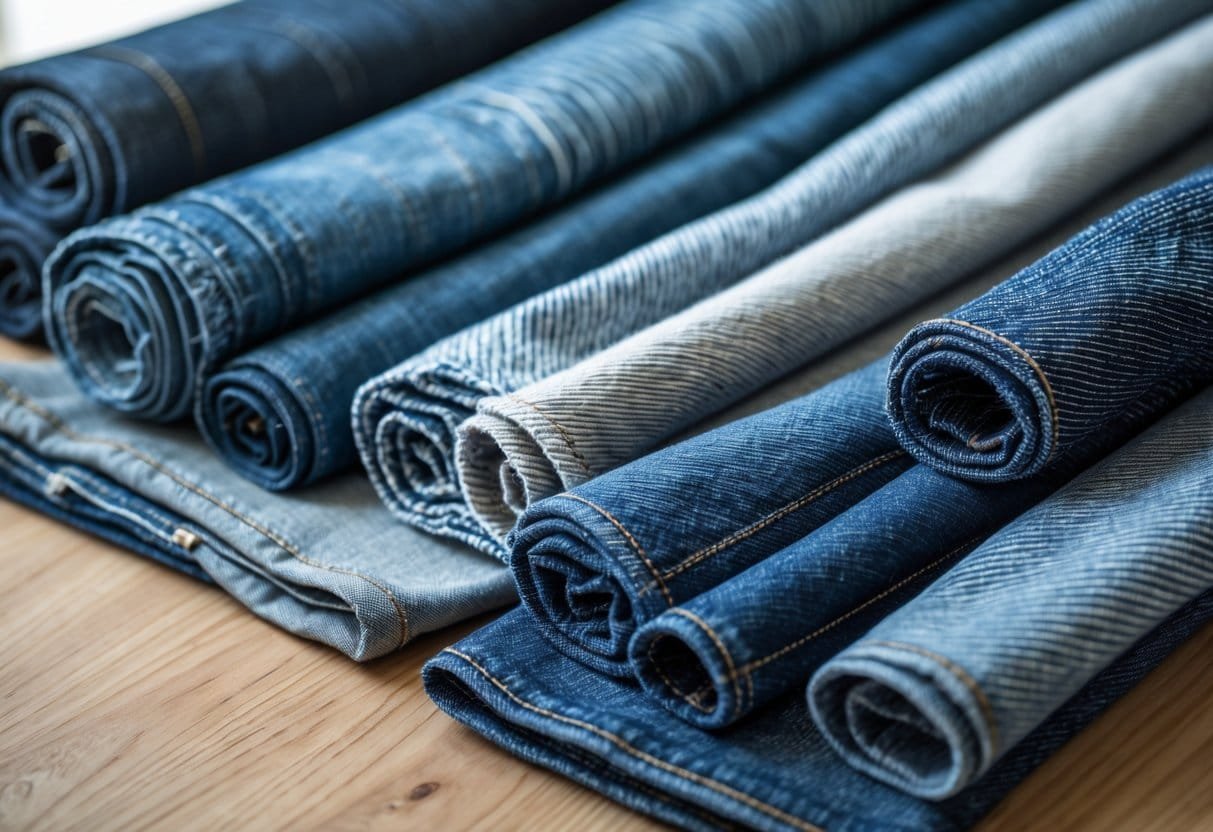
Slub denim is made using yarns that vary in thickness along their length. This gives the fabric an uneven texture with visible streaks and bumps. These irregularities create a unique look and feel that sets it apart from regular denim.
The uneven yarn thickness is intentional. It adds a natural, organic character to the fabric, often described as textured or rough. This texture can also affect how the denim fades over time, making each pair of slub denim jeans unique.
Slub denim is popular for its distinct appearance. It is less uniform and smooth compared to classic denim, which gives clothing a casual, lived-in vibe. The fabric is still durable, keeping the qualities people expect from denim while offering a new style element.
Manufacturers sometimes use special weaving methods to enhance these irregular patterns. This helps create a strong but visually diverse fabric. Slub denim appeals to those who want classic denim with a bit of extra texture and personality.
14) Lightweight Denim
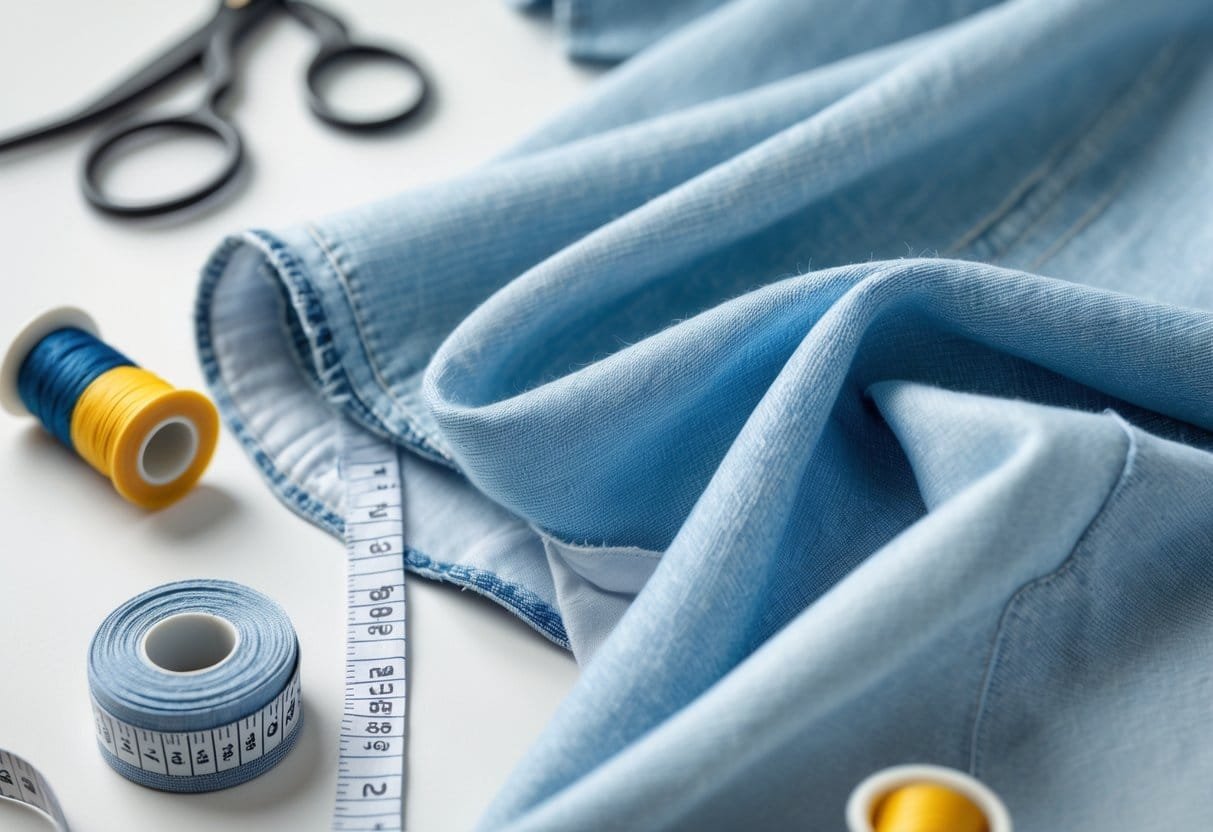
Lightweight denim is thinner and softer than regular denim. It usually weighs less than 10 ounces per square yard. This makes it more comfortable to wear, especially in warmer weather.
The fabric still has the classic denim look but feels lighter on the skin. It is often used for summer jeans, shirts, and jackets. Despite being lighter, it stays durable enough for everyday use.
This type of denim also tends to drape better. It moves more freely and is less stiff than heavier denim. People who prefer a relaxed fit may choose lightweight denim for its ease of movement.
Because it can be less thick, lightweight denim may fade and wear faster. It is important to follow care instructions to keep it looking good. Overall, lightweight denim offers a balance between comfort and durability.
Key Factors Influencing Jeans Fabric Choice
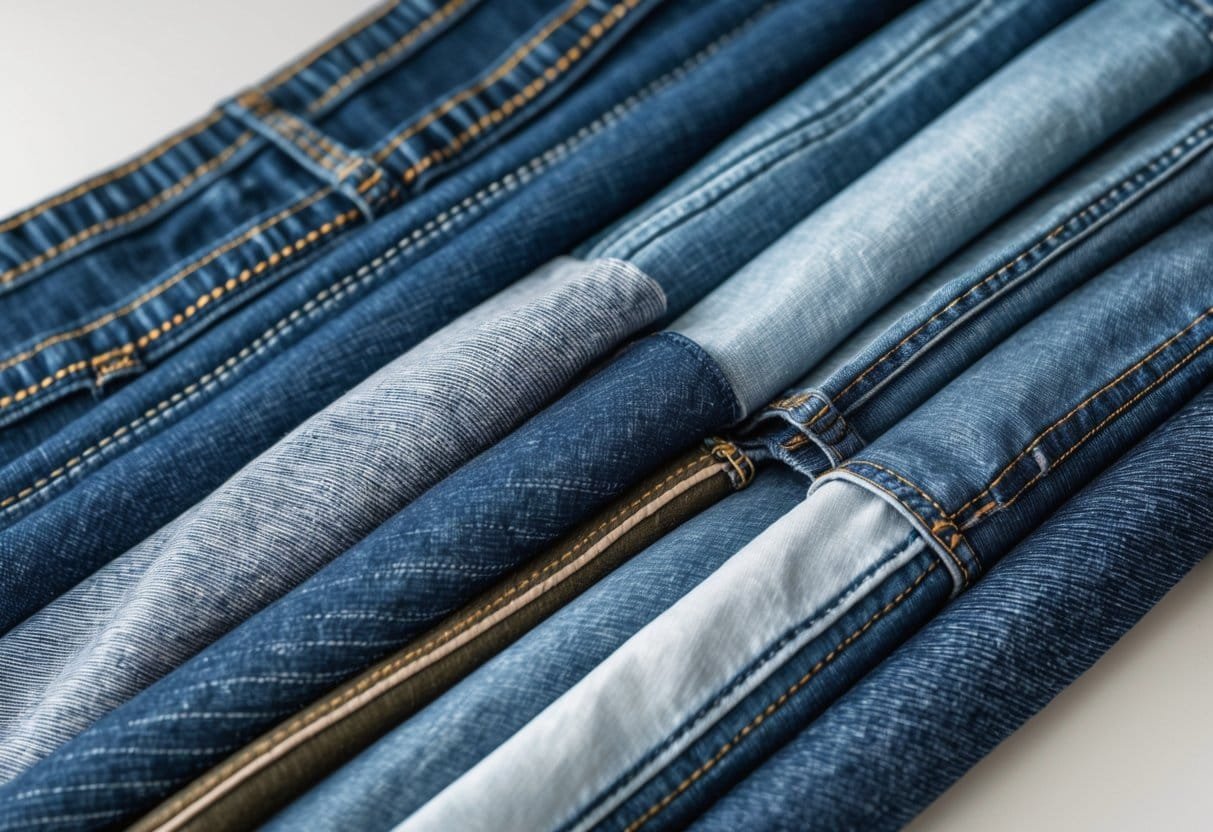
Jeans fabric choice depends on several important factors. These include how tough the material is, how comfortable it feels, how well it breathes, how to care for it, and whether it fits the look of the jeans style. Understanding these details helps pick the right fabric for both daily wear and fashion.
Durability and Comfort
Durability is one of the main concerns when choosing fabric for jeans. Fabrics like heavyweight raw denim are very tough and last a long time. They resist wear and tear but can feel stiff at first. Softer fabrics, such as stretch denim, mix cotton with elastic fibers like spandex. This blend improves comfort by allowing more movement.
Comfort depends on fabric weight and flexibility. Lighter denim is easier to wear for long periods but may not hold up as well. Heavier fabric offers strength but can limit motion. The right balance depends on how often the jeans will be worn and what activities the user will do. Denim with a small stretch percentage offers a good mix of strength and ease.
Breathability and Care Requirements
Breathability is key for jeans worn in warm weather or long hours. Pure cotton denim tends to breathe better than blends that include synthetic fibers. Breathable fabrics help reduce sweat and keep the wearer cool.
Care instructions vary with fabric type. Raw denim and heavyweight fabrics usually need less frequent washing to maintain shape and color. Stretch denim often washes well but may fade faster. Organic or specialty denims may require gentle washing and air drying to prevent damage. Proper care can extend the life of jeans and preserve their look.
Suitability for Different Styles
Different jeans styles call for different fabrics. Skinny jeans usually use stretch denim because it fits snugly and moves with the body. Classic straight-leg or bootcut styles often rely on sturdier denim for a traditional look.
Selvedge denim is prized for its clean edges and durability, making it popular among premium jeans. Lightweight denim suits casual or summer styles. Fabrics with unique finishes, like acid wash or coated denim, help achieve specific fashion looks. Choosing fabric based on style ensures the jeans look right and wear well over time.
Sustainability and Innovations in Jeans Materials
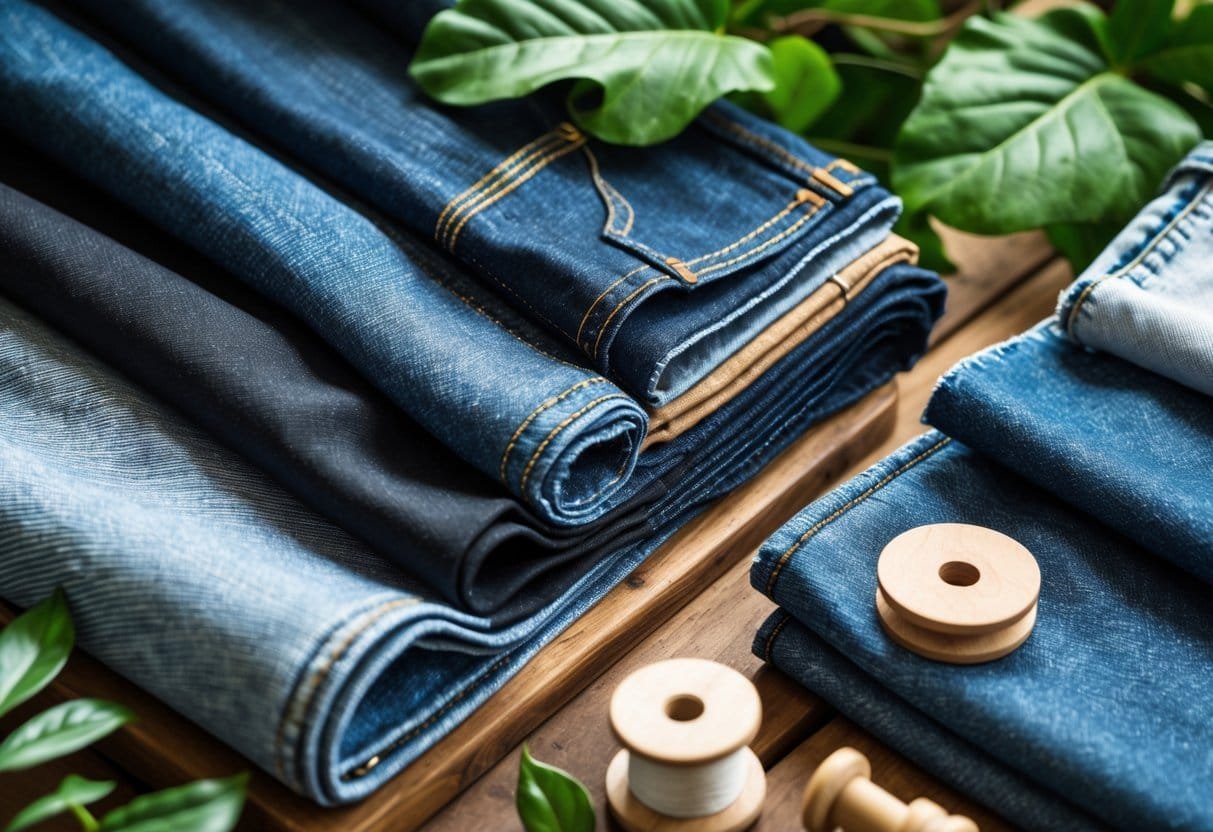
Jeans materials are evolving to include more eco-friendly options and improved performance fabrics. These changes aim to reduce environmental harm while increasing comfort and durability for wearers. Combining sustainability with technology is now common in denim production.
Eco-Friendly Denim Alternatives
Denim makers are using organic cotton and recycled fibers to minimize harmful impacts. Organic cotton avoids chemicals and pesticides, promoting healthier soil and water use. Recycled cotton and polyester reduce landfill waste by giving fabric another life.
Blending organic cotton with fibers like Tencel creates softer, more breathable denim that uses less water. Brands also adopt natural indigo dyes and waterless dyeing processes, cutting down on toxic waste and water consumption.
Many sustainable jeans include plastic-free stretch fabrics, which maintain flexibility without synthetic additives that harm the environment. These innovations help jeans brands offer styles that are both responsible and comfortable.
Advancements in Stretch and Performance Fabrics
New fabrics combine stretch with durability, improving jeans for active wear and daily comfort. Traditional spandex blends often rely on synthetic materials that may not be sustainable, so brands seek eco-friendly alternatives.
Plant-based stretch fibers and recycled elastane are gaining popularity. These materials support flexibility while reducing environmental impact during production. Performance denim now often includes moisture-wicking and temperature-regulating properties.
Smart textiles are also part of the innovation, with fabrics that respond to body heat or resist odors. These features enhance wearability without sacrificing sustainability. As a result, consumers can find jeans that perform well and align with eco-conscious values.
Frequently Asked Questions
The questions cover important details about denim fabrics, including their unique traits, how they affect jeans’ fit and feel, and what to watch for when choosing fabric types. They also explain color options, durability, comfort, and environmental impact.
What are the key characteristics of the main types of denim fabric?
Raw denim is stiff and unwashed, allowing it to fade uniquely over time. Selvedge denim features a clean edge with a tight weave, often seen as higher quality. Stretch denim includes elastic fibers for flexibility and comfort. Colored denim uses dyes beyond traditional indigo, adding vibrant shades. Stonewashed denim is pre-washed to create a softer feel and faded look.
How do different denim materials affect the fit and feel of jeans?
Stretch denim provides more comfort and moves with the body. Raw denim feels rigid at first but softens after wear. Selvedge denim tends to be thicker and holds shape well. Stonewashed denim feels softer out of the box, ideal for casual styles. Colored denim’s texture depends on its base fabric but often maintains durability.
Can you describe the various denim fabric specifications to look for?
Look for weight, usually measured in ounces per square yard—lighter denim for shirts or summer wear, heavier for durability. The weave type affects strength and texture, with twill being most common. Fabric finish includes raw, stonewashed, or distressed, each giving different looks and feels. Stretch content, often 1-3% elastane, impacts flexibility.
What are the visual differences among the types of denim colors available?
Raw denim has a deep, dark indigo shade. Selvedge denim often shows a clean edge with white and colored stitching. Colored denim appears in a variety of hues like black, red, or green using piece dyeing. Stonewashed denim has a faded, worn look with lighter patches. Distressed denim shows intentional wear marks for a vintage style.
How do jeans materials vary in durability and comfort?
Raw and selvedge denim are highly durable but take time to break in. Stretch denim sacrifices some durability for comfort, making it better for everyday wear. Stonewashed denim offers immediate softness but may wear out faster. Colored denim’s durability depends on the dye process and fabric quality.
What are the most eco-friendly types of jeans materials currently on the market?
Organic cotton raw denim reduces chemical use in growing cotton. Recycled denim blends cut down on waste. Some manufacturers use natural dyes or low-water stonewashing methods. These options aim to lower environmental impact while maintaining quality.


